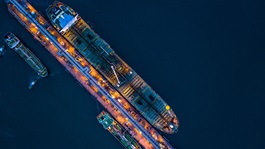
Publikation
Legalseas
Our shipping law insights provide legal and market commentary, addressing the key questions and topics of interest to our clients operating in the shipping industry, helping them to effectively manage risk.


Information correct as of September 2025
Policy overview and targets
Malaysia, where fossil fuels make up 96.6 percent of the country’s energy supply and whereby 2022 emissions reached 291 million tons of carbon dioxide, are working to play its part in the global fight against climate change and in the world’s sustainability endeavours and net zero ambitions. It submitted its Nationally Determined Contribution (NDC) in July 2021, with a commitment to reduce its carbon intensity by 45 percent against GDP by 2030 as compared to 2050 levels. Along with its NDC commitment, it also has key policy frameworks such as the 12th Malaysia Plan (2021 to 2025), the National Energy Policy (NEP) 2022-2040, the New Industrial Master Plan 2030 (NIMP) and the National Energy Transition Roadmap (NETR) which highlight its sustainability ambitions and the government planning considered in achieving its targets. Malaysia has also set a net zero target by 2050 and is looking into carbon capture and storage (CCS) and carbon capture, utilisation and storage (CCUS) technologies as an important avenue to allow it to achieve its net zero targets, especially in hard-to-abate sectors. In relation to the development of CCUS hubs, Malaysia has also set out a target to develop a total of seven hubs.1
An overview of the various key policy frameworks mentioned are above and the focus on CCS / CCUS technologies are further elaborated below:2
Regulatory framework overview
There have been a number of applicable regulatory instruments enacted by the Malaysian government, both in Peninsular Malaysia and East Malaysia.
Carbon Capture, Utilization and Storage Act 2025 (the CCUS Act 2025) enacted on 1 August 2025 (this expressly applies to Peninsular Malaysia and the Federal Territory of Labuan only, and does not extend to the East Malaysian states of Sabah and Sarawak):3

2022 Land Code (Carbon Storage) Rules (the 2022 Rules) (applies to Sarawak, East Malaysia):5
Environment (Reduction of Greenhouse Gases Emission) Ordinance 2023 (the 2023 Ordinance) (applies to Sarawak, East Malaysia):8
Kasawari CCS Project (Offshore – 200km off the northern coast of Bintulu, Sarawak) – The project, installed at a water-depth of 108 meters, is operated by PETRONAS Carigali, is one of the largest offshore CCS projects in the world and Malaysia’s first offshore carbon capture initiative, aims to capture up to 3.3 million tonnes of carbon dioxide annually from natural gas production and is tentatively scheduled to have the first carbon dioxide injection by the end of 2029 or early 2030. The project deploys energy-efficient gas turbines and PETRONAS's proprietary membrane technology to minimise emissions and also involves key contractors such as Malaysia Marine and Heavy Engineering (MMHE) (leading the engineering, procurement, construction, installation and commissioning services), the National Petroleum Construction Company (NPCC), Baker Hughes (who will provide the carbon dioxide compression equipment) and McDermott (who will handle the offshore installation of the pipeline and platform jacket).11
Lang Lebah CCS Project (Offshore – 90km off the northern coast of Miri, Sarawak) – The project, developed by PTT Exploration and Production Public Company Limited (PTTEP; Thailand’s national oil company), in partnership with PETRONAS Carigali and Kuwait Foreign Petroleum Exploration Company (KUFPEC), serves to manage the high levels of carbon dioxide and hydrogen sulphide present in the gas to be produced by the Lang Lebah gasfield (a gas field which holds an estimated 5 trillion cubic feet of gas with production expected to begin by 2027 and with a goal of producing 1 billion cubic feet of gas per day) by storing the captured carbon dioxide in the depleted Golok Field which is expected to begin in 2028. The project is part of the Sarawak Integrated Sour Gas Evacuation System (SISGES), aimed at monetising high-contaminant gas fields.12
BIGST CCS Project (Offshore – off the east coast of Peninsular Malaysia) – The project looks to develop the offshore Bujang, Inas, Guling, Sepat and Tujoh gas fields which hold around 4 trillion standard cubic feet of gas, but have been challenging to develop due to high carbon dioxide concentrations, and aims to develop these fields using carbon capture and storage technology, separating carbon dioxide from natural gas and injecting it into depleted reservoirs nearby. It is a collaboration between JX Nippon Oil & Gas Exploration Corporation (now known as ENEOS Xplora Inc.) and its subsidiary, JX Nippon Oil and Gas Exploration (BIGST) Sdn. Bhd., under a Production Sharing Contract (PSC) with PETRONAS and PETRONAS Carigali Sdn. Bhd.13
The above Malaysian projects aim to support Malaysia’s carbon neutrality goals while increasing also domestic gas supply, achieving the outcomes of economic gains, energy security and fulfilment of sustainability goals.
Key clusters for CCS development have been identified – Through collaborative studies including those led by PETRONAS, key clusters for CCS development have been identified. The proposed clusters which are designed to efficiently capture, process, and store carbon dioxide from various industrial sources, including both domestic and foreign emissions are:14
Research and Development in Carbon Capture and Storage Technologies: (1) Membrane Contactor (MBC) technology: PETRONAS’ MBC technology is a notable innovation in Malaysia’s CCS landscape and excels in carbon dioxide capture, achieving a capture efficiency of over 95 percent. Additionally, it has also integrated cost-effective design enhancements; and (2) Malaysia’s Ministry of Investment, Trade and Industry is also implementing the National Carbon Capture Project which looks to use the MBC technology to develop a carbon capture pilot plant for high-emitting industries as part of building a domestic carbon capture, utilisation and storage ecosystem. The innovative technology developed and the utilisation of these technologies in Malaysia’s carbon capture projects thus facilitate and accelerate Malaysia’s net zero goals.15
Collaboration between entities – State owned entities often play an active role in the CCS projects and collaborate with private and other entities through memoranda of understanding. The cross collaboration ensures that projects have a balance in relation to state and private interests and allows for cross sharing of CCS knowledge, thus enhancing the projects and benefiting Malaysia’s CCS ecosystem.16
Opportunities
Lowering the cost of capturing carbon by monetising captured carbon dioxide and converting them to commercially valuable products – The International Energy Agency has classified six application uses of carbon dioxide in the areas of construction materials (carbonated aggregates/concrete); synthetic fuels (e-fuels, methanol); chemicals (carbon monoxide, syngas, formic acid); polymers; carbon additives (e.g., nanotubes, carbon black); and ingredients (e.g., single-cell proteins, lipids). In relation to this, Malaysia is looking to utilise the captured carbon and focusing on commercialising it in the field of bio-based materials, carbon dioxide-enriched agriculture, and synthetic fuels.17
Challenges
Compliance with international maritime regulations in relation to cross border carbon dioxide transport to store carbon dioxide from foreign sources – Malaysia is not a signatory to the London Protocol (which evolved from the 1972 London Convention which prohibited marine dumping except for waste on the “reverse list”)18, which adopted an amendment in 2009 to allow the export of carbon dioxide streams for sequestration of carbon dioxide in sub-seabed geological formations provided that an agreement or arrangement has been entered into by the countries concerned.19. This will need to be an area of consideration for Malaysia given that it would need to comply with the high standards and regulation of the London Protocol when dealing with countries who have ratified the London Protocol in carbon dioxide imports to be stored in Malaysia.
Regulatory harmonisation to ensure a unified national carbon capture, utilisation and storage policy – Malaysia can be broadly divided into Peninsular Malaysia and East Malaysia (consisting of the states of Sabah and Sarawak that have a history of expressing a certain amount of autonomy). As mentioned above, the CCUS Act 2025 applies to Peninsular Malaysia and the Federal Territory of Labuan (an island located near Sabah) only, and does not extend to the East Malaysian states of Sabah and Sarawak, and the 2022 Land Code and the 2023 Ordinance applies only to Sarawak. The disharmonised application of the CCUS Act 2025 might be attributed to a particular history of political differences and governance concerns by Sabah and Sarawak in relation to resource management and decision making authority.20 Improvement in harmonisation between the states of Malaysia on a federal level is likely to assist Malaysia in projecting a harmonised front when entering into bilateral agreements with other countries in its pursuit of positioning itself as a regional CCS hub.
Avenues for utilisation and commercialisation of captured carbon would encourage and provide more impetus to companies and the Malaysian government to invest in CCS / CCUS projects. In relation to this, the national power generation and distribution company, Tenaga Nasional Berhad (TNB), is looking to apply biological and hydrogenation processes to transform captured carbon dioxide into high-value products (see illustration below on the possible product developed from captured carbon dioxide).21
Two of TNB’s key initiatives since 2011 are Project Bloom and Project Dragon:22
Developments of more of these and advancements in the technologies utilised in these carbon utilisation projects would not only ensure that carbon is captured and stored, preventing worsening global warming effects, but also add value to society by providing a commercially viable product, truly demonstrating the idea of a circular economy in the form of “recycling” carbon dioxide.

Publikation
Our shipping law insights provide legal and market commentary, addressing the key questions and topics of interest to our clients operating in the shipping industry, helping them to effectively manage risk.
Blog
Cheat-Software ist für Spielehersteller seit Langem ein Ärgernis. Doch stellt sie auch eine Urheberrechtsverletzung dar? In einer wegweisenden Entscheidung vom 31. Juli 2025 hat der Bundesgerichtshof (BGH) entschieden, dass Cheat-Tools, die lediglich In-Game-Variablen im RAM manipulieren – ohne den Programmcode zu verändern – nicht gegen das Softwareurheberrecht nach EU-Recht verstoßen.
Blog
Cheat software has long been a thorn in the side of game publishers. But does it also constitute a copyright infringement? In a landmark decision, issued on 31 July 2025, the German Federal Court of Justice (BGH) ruled that cheat tools that merely manipulate in-game variables in RAM - without altering the program code - do not violate software copyright under EU law.
Subscribe and stay up to date with the latest legal news, information and events . . .
© Norton Rose Fulbright LLP 2025